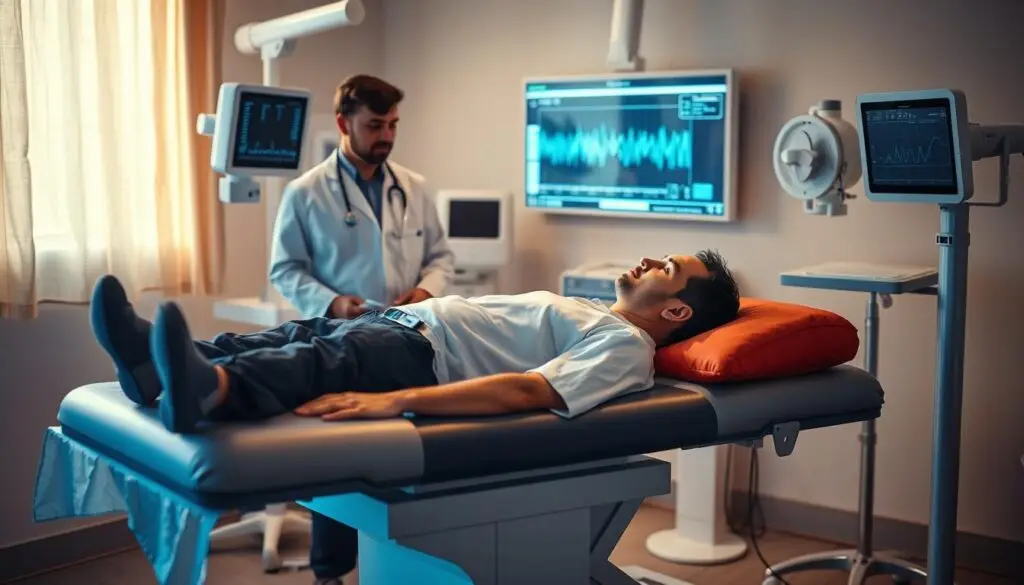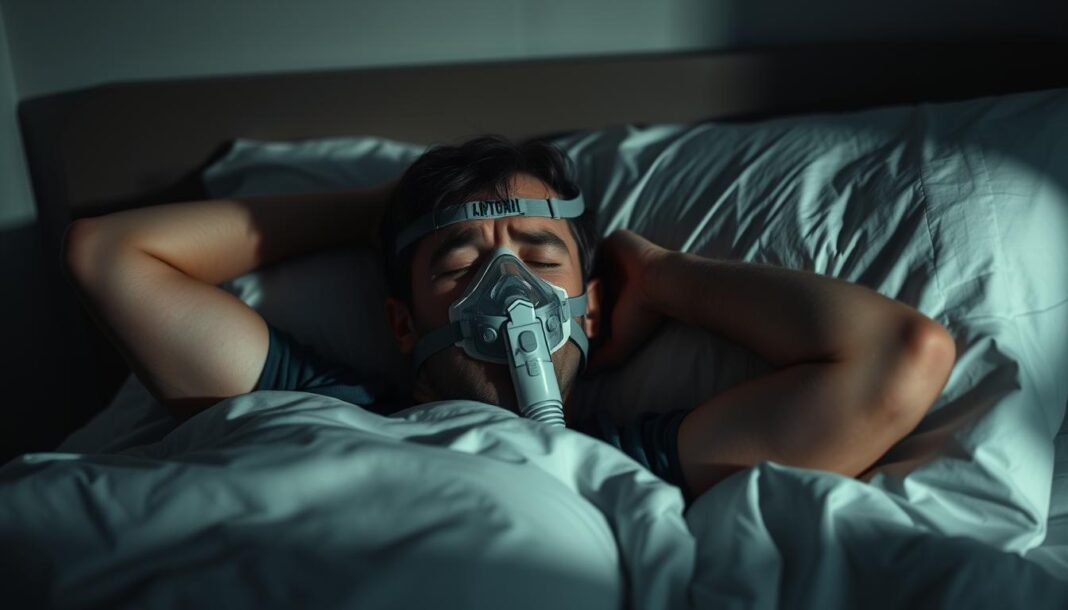If you suspect a breathing problem at night, act now. Sleep apnea causes repeated pauses in breathing that can last from ten seconds to over a minute. In severe cases, these events may happen more than 30 times per hour.
The interruptions lower oxygen levels and break restorative sleep because your brain briefly rouses you to restart breathing. Over time, fragmented rest can strain your heart and blood vessels and hurt your overall health.
If people close to you notice loud snoring, gasps, or pauses, that is a clear cue to seek evaluation. The good news: diagnosis is straightforward and treatment can restore energy, mood, and daily focus.
This guide gives a simple action plan. Learn the main warning signs, see how testing works, and find practical steps you can try tonight while you consider professional care.
Key Takeaways
- Sleep apnea disrupts breathing and lowers oxygen during the night.
- Frequent pauses can fragment sleep and harm cardiovascular health.
- Loud snoring, gasps, or observed pauses are important cues.
- Diagnosis and effective treatment can restore better sleep and energy.
- Simple changes tonight can help while you arrange a medical review.
Understanding Sleep Apnea Right Now: What Happens While You Sleep
Frequent pauses in breathing at night can cut your sleep into tiny fragments and reduce the oxygen your body needs. This is central to understanding sleep apnea and why it affects energy and mood.
Apnea events occur when the airway narrows or when the brain briefly stops sending the right breathing signals. Each event forces a short arousal so breathing can restart, which wrecks sleep continuity.
- Episodes may happen many times per hour and often go unnoticed by the person sleeping.
- Partners commonly report gasps, loud breathing, or pauses that the sleeper does not recall.
- Lowered oxygen during repeated events adds stress to your cardiovascular system and daily functioning.
| Severity | Events per Hour | Typical Impact |
|---|---|---|
| Mild | 5–15 | Light sleep fragmentation, possible daytime tiredness |
| Moderate | 15–30 | Clear disruption to sleep quality and attention |
| Severe | 30+ | Major oxygen dips, higher health risk |
Understanding sleep patterns helps you spot issues early and move toward testing and treatment.
Acting on what you learn tonight can speed diagnosis and protect long-term health.
Signs of Sleep Apnea You Shouldn’t Ignore
Loud, repeated disruptions at night often mean your breathing stalls and your body keeps waking to catch up. Pay attention when several symptoms appear together. That pattern raises the chance that a treatable condition is affecting your rest.
Loud, persistent snoring that disrupts your night
If snoring is chronic and noisy, it can mark blocked airflow. Partners who report gasps or pauses make this a key warning sign.
Choking, gasping, or pauses in breathing during sleep
These events often happen without memory. When someone nearby hears choking or abrupt gasps, get evaluated.
Excessive daytime sleepiness and fatigue
Waking tired, nodding off during the day, or feeling heavy fatigue suggests fragmented sleep cycles. That daytime fog ties back to repeated nighttime arousals.
Morning headaches and a dry mouth
Waking with soreness in your throat or a dry mouth often follows mouth breathing and disrupted airflow. Morning headaches are another common symptom linked to poor sleep.
Frequent nighttime bathroom trips (nocturia)
Getting up to urinate multiple times can reflect repeated arousals that pull you from deep sleep. It’s more than an inconvenience—it can be a clue.
Difficulty staying asleep and poor sleep quality
Restless tossing, multiple wake-ups, and low-quality rest are classic signals. Many people dismiss these as stress or aging, but when clustered they point toward sleep apnea.
“If several of these signs resonate, seek a professional evaluation so you can move from guessing to an actionable plan.”
Take action: note which signs you notice and bring them to your clinician. Early testing and treatment can restore better days and safer nights.
Unusual Symptoms Many People Overlook
Vivid nightmares or missing dreams can signal disrupted REM when breathing stalls at night. This happens because repeated brief awakenings scramble normal dream cycles and leave you unsettled in the morning.
Bad dreams, vivid nightmares, or no dreams at all
If your nights bring intense nightmares or you rarely recall dreaming, consider that apnea may be interrupting REM. Many people dismiss this as stress, but it can reflect poor sleep and altered REM timing.
Brain fog and trouble focusing during the day
Daytime fog, attention lapses, and slowed thinking occur when the brain gets less reliable oxygen overnight. These cognitive issues often track with fragmented rest.
Sleepwalking, sleep talking, or sleep eating (parasomnias)
Parasomnias can surface when sleep architecture is unstable. If a partner reports unusual behaviors at night, note them for your clinician.
Sleep paralysis when drifting in or out of sleep
Brief paralysis episodes during transitions may be more likely with disrupted sleep cycles and fragmented breathing.
Dry mouth, drooling, or a sore, scratchy throat in the morning
Waking with a dry mouth or sore throat often follows mouth breathing and heavy snoring overnight.
Night sweats linked to fluctuating oxygen levels
Sweating at night can coincide with changing oxygen levels during events that strain temperature control. If these issues cluster with other signs, seek testing.
“Track what you or a partner observes for a week — clear notes help connect night events to likely causes.”
Why You Shouldn’t Ignore These Warning Signs
When breathing repeatedly falters during sleep, the result is more than tired mornings. It creates ongoing strain on vital systems and raises a clear risk to long-term health.
Risks to your heart health: high blood pressure, AFib, stroke
Untreated sleep apnea increases the chance of atrial fibrillation and other serious heart events. Constant oxygen dips and fragmented rest place extra pressure on blood vessels and the heart.
Over time this cycle can lead to hypertension, heart failure, and stroke. For many patients, treating apnea lowers blood pressure and helps stabilize heart rhythms.

Safety concerns from daytime drowsiness (including driving)
Excessive daytime sleepiness is not only uncomfortable — it is dangerous. Drowsy driving and mistakes at work or with machinery raise immediate threats to your safety and others.
Ignoring loud nights and foggy days can shorten quality of life. Acting now reduces cumulative damage and helps you stay alert when it matters most.
- Untreated apnea raises risk for high blood pressure, AFib, heart failure, and stroke.
- Oxygen dips and sleep fragmentation increase strain on your cardiovascular system and blood vessels.
- Daytime drowsiness impairs reaction time and judgment—especially behind the wheel.
“Do not normalize noisy nights or tired days — addressing this issue now protects your heart and daily performance.”
Types of Sleep Apnea and How They Differ
Not all breathing pauses are the same; the root cause changes how you treat them.
Obstructive sleep apnea (OSA)
Obstructive events occur when the airway narrows or collapses. The tongue or relaxed throat tissues can block flow, making OSA the most common condition and affecting millions.
Central sleep apnea
Central events start in the brain when breathing signals falter. There is no physical blockage; instead, control of breathing becomes irregular and shallow.
Complex sleep apnea
Complex cases show features of both types. They can appear when treating one form leads to the other, so care must be tailored.
- Why type matters: therapy, device settings, and follow-up differ by diagnosis.
- Risk factors vary: excess weight or narrow airway raise OSA chances; heart issues, opioids, or stroke link to central events.
- The number of times breathing stops each hour defines severity and guides treatment to protect heart and blood health.
“Accurate testing clarifies what is driving nightly events and speeds effective care.”
To learn more and prepare for evaluation, learn more about sleep apnea.
How Sleep Apnea Is Diagnosed Today
Diagnosis starts with capturing what happens at night—either in your bedroom or in a monitored lab. Your primary care provider can order a home sleep test or refer you to a specialist who decides which study fits your situation.
Home sleep testing versus overnight sleep lab studies
Home sleep testing uses compact gear to record breathing, airflow, and oxygen while you sleep in your own bed. It is convenient and often delivers faster results.
In-lab polysomnography records more channels: brain waves, muscle tone, oxygen, and body position. This overnight study is best when central events or other disorders are suspected.

When to see your primary care provider or a sleep specialist
If you notice warning signs, start with your primary care provider. They can arrange testing or send you to a sleep specialist who interprets results and prescribes treatment based on severity and type of apnea.
- Tests report how many times breathing is disrupted per hour and show oxygen patterns critical for your health.
- Clear diagnosis unlocks care options—from PAP devices to dentist-fitted oral appliances—and a plan that fits your life.
- Ask about follow-up so therapy can be fine-tuned for comfort and effectiveness.
Patients often feel relief once they know what’s happening and have a path forward.
Treatment Options That Help You Breathe Better
A clear treatment plan can stop nightly breathing gaps and restore steady, deep rest. Your care team will match options to your condition, lifestyle, and goals so therapy works night after night.
Positive airway pressure to keep airflow steady
PAP machines deliver gentle pressure through a mask to hold the airway open. That reduces events and stabilizes oxygen levels across the night.
Oral appliance therapy for a simpler fit
Oral appliances are dentist-made and advance the lower jaw to prevent collapse. Many patients prefer them for mild to moderate conditions or when PAP is not tolerated.
Lifestyle, neuro-stimulation, and surgical care
Weight loss, side-sleeping, and treating nasal congestion boost any device’s effect. Neuro-stimulation implants prompt muscles to support breathing rhythms for select patients.
Surgery targets structural blockage when other therapies fall short.
| Option | When used | Benefits |
|---|---|---|
| PAP devices | Moderate–severe cases, immediate relief | Reduces events, improves oxygen, lowers cardiovascular strain |
| Oral appliances | Mild–moderate or PAP-intolerant patients | Comfortable, portable, improves airflow and sleep quality |
| Neuro-stimulation / Surgery | Selected anatomical or treatment-resistant cases | Targets root cause, can restore natural breathing patterns |
Consistent use and follow-up matter most—small adjustments to devices or settings often yield big comfort and health gains.
Oral Appliance Therapy: A CPAP Alternative Many Patients Prefer
A custom mouthpiece can be a quiet, travel-friendly alternative that eases nighttime airway collapse. This option is one of the leading oral appliances used for sleep apnea.
How mandibular advancement devices keep your airway open
Mandibular advancement devices gently push your lower jaw forward so the tongue and soft tissues do not fall back. That simple shift helps keep the airway clear and reduces breathing interruptions.
Benefits: comfort, portability, and better sleep without noise
Oral appliances are compact, silent, and worn in the mouth at night. Many patients prefer them to masks because they remove hoses and the noise that comes with pressure devices.
You may notice less snoring, fewer awakenings, and more consistent energy during the day. That leads to improved sleep and overall quality of life for many people.
Getting started: consultation, custom fit, and follow-up adjustments
Begin with a visit to a dentist trained in dental sleep medicine. The dentist will check your mouth, take impressions, and craft a custom-fit device.
Expect follow-up visits to tune comfort and effectiveness. Small adjustments often yield big gains and help appliance long-term adherence as a viable treatment.
“A well-fitted device can help you avoid bulk and noise while delivering meaningful relief for mild to moderate sleep apnea.”
What You Can Do Tonight to Protect Your Sleep and Health
Tonight’s routine can both improve rest and create useful evidence for a faster diagnosis. Make a few simple choices that lower immediate risk and help a clinician spot key signs sleep apnea.
Ask a partner to watch and record
Have someone note snoring volume, gasps, and pauses during the night. These real-time notes give clear clues your provider can use at evaluation time.
Cut alcohol and try side-sleeping
Avoid drinking within several hours before bed. Alcohol relaxes airway muscles and raises the chance of breathing disruptions.
Sleep on your side with a body pillow to keep that position. Many people with position-sensitive apnea sleep better this way.
- Keep the room cool, dark, and quiet to support deeper rest while you arrange testing.
- Track wake times and morning energy for one to two weeks to spot patterns that help diagnosis.
- If nasal congestion bothers you, try saline rinses or a doctor-approved decongestant to ease airflow.
These steps can help tonight, but they do not replace formal testing. If daytime drowsiness worsens, avoid driving and seek medical care promptly.
Conclusion
A timely evaluation turns uncertainty into a clear plan that protects your blood pressure and heart.
Many people live with poor sleep for years, yet the right action can restore energy and a better quality life. Treatment choices fit different needs, and adherence over time brings real gains in quality and reduced fatigue.
If you notice warning signs, schedule testing so clinicians can decide on PAP, an oral appliance, or other care. Understanding sleep and understanding sleep apnea helps link morning fatigue and blood changes to a manageable condition.
Act now: share notes with your clinician, pick a treatment you can follow, and trade restless nights for steadier days and stronger health.



